SilkAir
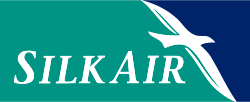 | |||||||
| |||||||
| Founded | 1989 (as Tradewinds) | ||||||
|---|---|---|---|---|---|---|---|
| Commenced operations | 1992 | ||||||
| Hubs | Singapore Changi Airport | ||||||
| Frequent-flyer program | KrisFlyer | ||||||
| Fleet size | 33 | ||||||
| Destinations | 49 | ||||||
| Company slogan | A Joy To Fly | ||||||
| Parent company | Singapore Airlines | ||||||
| Headquarters | Singapore | ||||||
| Key people | Foo Chai Woo (CEO)[1] | ||||||
| Revenue |
| ||||||
| Operating income |
| ||||||
| Profit |
| ||||||
| Employees | 1,574 (FY 2017/2018)[2] | ||||||
| Website | www.silkair.com | ||||||
SilkAir (Singapore) Private Limited[3] is a full service regional airline with its head office in Airline House in Singapore;[4] previously the head office was on the fifth storey of the SIA Superhub in Singapore.[5] It is a wholly owned subsidiary of Singapore Airlines and operates scheduled passenger services from Singapore to 52 cities in 16 countries in Southeast Asia, the Indian Subcontinent, China, Japan and Australia.
As the regional wing of Singapore Airlines, it serves the short to medium haul destinations in the Singapore Airlines Group network. For the year ending 31 March 2015, the airline flew over 3.5 million passengers and made an operating profit of S$40.8 million.[6]
As of 31 March 2016, SilkAir employs 1,573 staff. SilkAir announced the appointment of Mr Foo Chai Woo as Chief Executive as of 18 May 2016, succeeding Mr Leslie Thng.[7]
For the financial year ending 31 March 17, SilkAir registered revenue of S$990.3 million, a 2.5% increase versus the previous year. Operating profit was at an all-time high of S$100.8 million, a 11.3% increase against the previous year. Profit after tax was at S$59 million, a decline of 51.6%, largely attributed to an absence of a gain from SilkAir's sale and leaseback of four 737-800s reported in financial year 2015/16.[8]
As of 31 March 2017, SilkAir's staff strength is at 1,632 staff.
On 18 May 2018, Singapore Airlines announced that the SilkAir fleet will undergo major cabin product upgrade from 2020 before being fully merged into the parent company.[9][10][11]
History
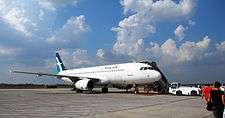
The airline had its roots as a regional air-charter company as Tradewinds Charters formed in 1975,[12] serving leisure destinations using planes predominantly leased from parent airline Singapore Airlines. Scheduled services were introduced as Tradewinds Airlines on 21 February 1989, when it leased McDonnell Douglas MD-87 aeroplanes for services to 6 destinations: Pattaya, Phuket, Hat Yai and Kuantan from Singapore's Changi International Airport and Tioman from Singapore's Seletar Airport. As the carrier matured, regional business destinations such as Jakarta, Phnom Penh and Yangon were added to its network, thereby broadening the airline's appeal beyond the holiday-maker to include the business traveller.
A major marketing overhaul was started in 1991, culminating on 1 April 1992, by giving the airline its present name and logo as a new corporate identity. The re-branded airline utilised up to six of the new Boeing 737-300s introduced just a year earlier. The mid-1990s saw two Airbus A310-200 aircraft in use and the expansion of services to India as well as mainland China. It was the first Asian carrier to offer handheld portable video-on-demand (VOD) in-flight entertainment in the form of the DigEplayer 5500, available on flights to selected countries.[13]
On 10 April 2015, SilkAir launched a new collection of uniforms, the fourth uniform change in over 26 years. There are two variations of the uniform - aqua-blue for junior crew and a plum-red version for senior crew. Both variations are accompanied by a dark blue skirt.[14]
On 29 October 2017, SilkAir took over Scoot's services to Yangon. With the transfer, the airline boosted its Yangon operations to 15 non-stop services a week.[15] On 30 October 2017, SilkAir launched its inaugural flight to Hiroshima, marking the first Japanese destination that SilkAir has added to its network.[16] On 25 January 2018, SilkAir announced that its services to Langkawi, Pekanbaru and Kalibo will be transferred to Scoot over the months of April to June 2018.[17]
Business trends
The key business trends for SilkAir are shown in the following table, for each financial year ending 31 March:
| Year ending 31 March: | ||||||||
|---|---|---|---|---|---|---|---|---|
| 2009 | 2010 | 2011 | 2012 | 2013 | 2014 | 2015 | 2016 | |
| Total Revenue (S$m) | 546.3 | 538.5 | 670.3 | 750.8 | 846.0 | 856.6 | 902.5 | 965.7 |
| Operating Profit (S$m) | 33.6 | 49.2 | 121.4 | 104.6 | 96.7 | 34.5 | 40.8 | 90.6 |
| Passengers carried (thousands) | 1,954 | 2,356 | 2,764 | 3,032 | 3,295 | 3,411 | 3,553 | 3,836 |
| - passenger change year-on-year | ||||||||
| Passenger load factor (%) | 72.5 | 77.1 | 76.4 | 75.7 | 73.6 | 69.6 | 70.2 | 71.5 |
| Number of aircraft (at year end) | 16 | 18 | 18 | 20 | 22 | 24 | 27 | 29 |
| Number of staff (at year end) | 876 | 944 | 1,116 | 1,192 | 1,360 | 1,462 | 1,452 | 1,573 |
| Sources | [18][19] | [18][20] | [18][20] | [18] | [18] | [21] | [6] | [22] |
Destinations
As of 30 June 2018, SilkAir flies to 49 destinations in 16 countries.
Codeshare agreements
SilkAir codeshares with the following airlines:[23][24]
Fleet
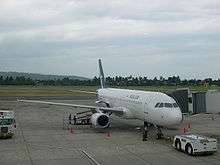
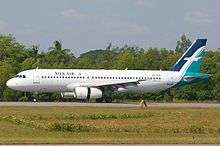
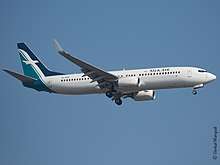
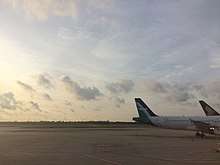
SilkAir began operations with two leased McDonnell Douglas MD-87 aircraft in 1989, before investing in its own fleet of six Boeing 737-300s, the first of which began operations in 1990. It operated two Airbus A310-200s for a brief period from 1993 to 1995 before they were transferred to Singapore Airlines, and two Fokker 70s from 1995 to 2000. It began replacing its Boeing fleet with Airbus aircraft when the first Airbus A320-200 arrived on 18 September 1998, and retired all Boeing aircraft a year later.[29] Soon after its first A320 was delivered, SilkAir took delivery of its first A319-100 aircraft on 3 September 1999. The A319 is currently utilised on certain routes within Southeast Asia, and to some cities in India, while the larger A320 is used on most of the airline's major routes. On 20 December 2006, SilkAir signed an agreement to purchase 11 Airbus A320-200 aircraft with nine more on option. These aircraft were delivered between 2009-2012.[30]
On 3 August 2012, SilkAir had signed a letter of intent with Boeing for a purchase of 68 aircraft. The agreement includes a firm order for 23 Boeing 737-800s and 31 Boeing 737 MAX 8 aircraft, and purchase rights for another 14 aircraft.[31] On 14 November 2012, the commitment was then converted to a firm order.[32] The 737 aircraft will be used to replace the older A320 fleet and for the expansion of the airline. On 4 February 2014, SilkAir received its first Boeing 737-800 aircraft.[33] On 4 October 2017, SilkAir received its first Boeing 737 MAX 8 aircraft.[34]
On 21 June 2018, Singapore Airlines announced that it plans to transfer a number of Boeing 737-800 to Scoot between late-2018 to early-2019 to better optimise the overall group's network.[35]
As of 31 August 2018, the SilkAir fleet consists of the following aircraft:[36]
| Aircraft | In Service | Orders | Options | Passengers | Notes | ||
|---|---|---|---|---|---|---|---|
| J | Y | Total | |||||
| Airbus A319-100 | 3 | — | — | 8 | 120 | 128 | To be phased out. |
| Airbus A320-200 | 8 | — | — | 12 | 138 | 150 | |
| Boeing 737-800 | 17 | — | 14 | 12 | 150 | 162 | All to be transferred to Scoot by 2021.[37] |
| Boeing 737 MAX 8 | 5 | 32 | 12 | 144 | 156 | Deliveries until 2022.[38] | |
| Total | 33 | 32 | 14 | ||||
| Aircraft | Total | Introduced | Retired | Notes | Refs |
|---|---|---|---|---|---|
| Airbus A310-200 | 2 | 1993 | 1995 | Leased from Singapore Airlines | |
| Boeing 737-300 | 6 | 1990 | 1999 | 9V-TRF was written off as SilkAir Flight 185 | [39] |
| Fokker 70 | 2 | 1995 | 2000 | Disposed to KLM Cityhopper | |
Loyalty programs
SilkAir shares the KrisFlyer frequent flyer program with its parent company, Singapore Airlines.[40] However, unlike Singapore Airlines, SilkAir is not a member of Star Alliance, so frequent flyer miles on SilkAir flights may only credited on the KrisFlyer programme, but not on other Star Alliance frequent flyer programs.[41]
Cabins
There are two classes of cabins available on all SilkAir flights — Business class and Economy class.[42]
On 18 May 2018, Singapore Airlines announced that SilkAir will undergo a major cabin product upgrade from 2020. The upgrade will see the latter having new lie-flat seats in Business class, and the installation of seat-back in-flight entertainment systems in both Business and Economy classes.[9]
Business Class
The Business class cabins offer a seat pitch of between 39 and 40 inches and seat width between 20-22 inches. Passengers now receive leather seats on all aircraft.
On the Boeing 737 MAX 8 aircraft, seat pitch has been increased significantly to 49 inches in Business Class with additional seat recline.
Economy Class
All Economy class cabins on SilkAir have a seat pitch of 31 inches and seat width between 17-18 inches.
On the Boeing 737 MAX 8 aircraft, there are seat-back tablet and phone holders, and personal in-seat USB charging ports.
On-board amenities
Dining
SilkAir offers Oriental and Western menus. Light snacks are also available on selected flights of less than one and a half hours. SilkAir launched their All-Time Favourites dishes in July 2016 where they served a great selection of Asian, Western and local cuisine like Nasi Lemak, Hainanese Chicken Rice, Beef Tenderloin, etc. where Business Class passengers can pre-book in advance before flight.[43]
Entertainment
SilkAir offers a selection of magazine titles on board and screens a series of short features on their 11-inch inflight screens. The Silkwinds inflight magazine is complimentary for all passengers. In-seat audio is also available on the Boeing 737-800 aircraft.
SilkAir Studio
SilkAir Studio was introduced in 2014 where passengers on SilkAir flights will be able to stream blockbuster hits, short features, as well as chart-topping music to their personal laptops and handheld devices via Wi-Fi. This system will complement the existing overhead systems. Passengers in Business Class on flights more than two hours will be offered a tablet.
In May 2017, SilkAir Studio was enhanced and upgraded where there are now more than 150 international blockbuster movies and TV sitcom shows available on SilkAir Studio.[44] For Apple users, the SilkAir Studio app has to be downloaded prior to flight in order to enjoy the inflight entertainment.
Tradewinds Tours and Travel
Tradewinds Tours and Travel Private Limited is a wholly owned subsidiary of SilkAir, providing package tours to destinations flown by the airline, as well as chartered flights within the Asia region. The company was incorporated in 1975, and became a fully licensed tour operator in 1984.
SilkAir, the regional wing of Singapore Airlines, was once known as Tradewinds Charters at its founding in 1976, before earning its present name in 1991. The chartered operations were hence continued to be handled by Tradewinds Tours and Travel.
Incidents and accidents
On 19 December 1997, SilkAir Flight 185, operated on a Boeing 737-300 and piloted by Captain Tsu Way Ming, plunged into the Musi River in Sumatra during a routine flight from Jakarta to Singapore, killing all 104 people on board. The crash was investigated by various groups, with different results. The Indonesian NTSC, who were lead investigators, stated that they were unable to determine the cause, while the US NTSB concluded that the crash resulted from an intentional act by a pilot, most likely the captain.[45][46] A civil lawsuit case against Parker Hannifin, the manufacturer of the PCU-dual servo unit essential in the 737's rudder control—and also suspected in causing the crashes of United Airlines Flight 585 and USAir Flight 427 under similar flight-event parameters, had provided the NTSB the initial test results of the recovered PCU-dual servo unit from Flight 185 in 1997, but was later further independently investigated for litigation on behalf some families of Flight 185 passengers in a civil lawsuit against Parker Hannifin.[47] The jury under the Superior Court in Los Angeles in 2004, which was not allowed to hear or consider the NTSB conclusions, decided that the crash was caused by a prominent issue inherent in other 737 crashes: a defective servo valve inside the Power Control Unit (PCU) which controls the aircraft's rudder, causing a rudder hard-over and a subsequent uncontrollable crash. The manufacturer of the aircraft's rudder controls and the families later reached an out of court settlement.
References
- ↑ "SilkAir appoints new chief executive". The Business Times. Retrieved 19 May 2016.
- 1 2 3 4 "Annual Report FY2017/18 - Singapore Airlines" (PDF). Singapore Airlines.
- ↑ "Singapore Airlines Annual Report 2009/2010" (PDF). Singapore Airlines. p. 67. Archived from the original (PDF) on 2010-10-11.
- ↑ "Singapore Air Operators." (Archive) Civil Aviation Authority of Singapore. Retrieved on 31 October 2012. "05-D Airline House, 25 Airline Road, Singapore 819829"
- ↑ "Directory: World airlines." Flight Global. 30 March-5 April 2004. p. 68. "Core L, 5th Storey, SIA Superhub 1, 30 Airlines Road"
- 1 2 "Singapore Airlines Annual Report 2014/2015" (PDF). Archived from the original (PDF) on 4 March 2016. Retrieved 3 July 2015.
- ↑ Ramchandani, Nisha. "SilkAir appoints new chief executive". The Business Times. Retrieved 2018-02-01.
- ↑ "Singapore Airlines Annual Report" (PDF).
- 1 2 "SilkAir To Undergo Major Cabin Product Upgrade And Be Merged Into SIA". www.singaporeair.com. Retrieved 18 May 2018.
- ↑ "SilkAir to merge into Singapore Airlines after undergoing $100m revamp of cabin products". The Straits Times. 18 May 2018.
- ↑ "SilkAir to be merged with Singapore Airlines after cabin revamp". Channel NewsAsia. Retrieved 18 May 2018.
- ↑ http://www.silkair.com/jsp/cms/en_UK/mi_global_footer/our-heritage.jsp
- ↑ "Inflight Entertainment". SilkAir. Archived from the original on 2011-06-14.
- ↑ "SilkAir Takes to the Skies in a Sophisticated New Look".
- ↑ "SilkAir To Take Over Scoot's Yangon Services". www.silkair.com. Retrieved 9 October 2017.
- ↑ "Non-Stop Flight between Singapore and Hiroshima Launched on SilkAir's New MAX 8 Today". www.silkair.com. Retrieved 30 October 2017.
- ↑ "Scoot to Take Over SilkAir's Langkawi, Pekanbaru and Kalibo Services". www.silkair.com. Retrieved 25 January 2018.
- 1 2 3 4 5 "Singapore Airlines Annual Report 2012/13" (PDF). Singapore Airlines Group. Archived from the original (PDF) on 27 March 2014. Retrieved 8 January 2014.
- ↑ "Singapore Airlines Annual Report 2008/09" (PDF). Singapore Airlines Group. Archived from the original (PDF) on 17 April 2012. Retrieved 8 January 2014.
- 1 2 "Singapore Airlines Annual Report 2010/11" (PDF). Singapore Airlines Group. Archived from the original (PDF) on 19 October 2013. Retrieved 8 January 2014.
- ↑ "Singapore Airlines Annual Report 2013/2014" (PDF). Archived from the original (PDF) on 14 July 2014. Retrieved 29 July 2014.
- ↑ "Singapore Airlines Annual Report 2014/2015" (PDF).
- ↑ "Profile on SilkAir". CAPA. Centre for Aviation. Archived from the original on 2016-10-29. Retrieved 2016-10-29.
- ↑ "Partner airlines". www.silkair.com.
- ↑ "Singapore Airlines And SilkAir To Codeshare With Fiji Airways". www.singaporeair.com. Retrieved 17 April 2018.
- ↑ "SINGAPORE AIRLINES AND SILKAIR TO CODESHARE WITH FIJI AIRWAYS". www.fijiairways.com. Retrieved 17 April 2018.
- ↑ "Singapore Airlines And SilkAir To Codeshare On Scoot Flights". www.singaporeair.com.
- ↑ "Singapore Airlines And SilkAir To Codeshare On Vistara Flights". www.singaporeair.com.
- ↑ "Airfleets: SilkAir". Airfleets.net.
- ↑ "SilkAir Places New Order For 20 Airbus A320 Planes, To Meet Growth And Fleet Renewal" (Press release). SilkAir. 20 December 2006. Archived from the original on 29 September 2007. Retrieved 6 August 2010.
- ↑ Toh, Mavis (3 August 2012). "SilkAir signs LOI for 31 Boeing 737-8s, 23 737-800s". Flightglobal.com. Retrieved 2 November 2012.
- ↑ "Boeing, SilkAir Finalize Order for 54 737s" (Press release). Boeing. Retrieved 15 November 2012.
- ↑ "Boeing, SilkAir Begins Transition to All 737 Fleet" SilkAir. retrieved 6 February 2014.
- ↑ "SilkAir Marks New Era With Arrival of First Boeing 737 MAX 8". www.silkair.com.
- ↑ "Singapore Airlines to shift planes from SilkAir to budget arm Scoot". Channel NewsAsia. Retrieved 21 June 2018.
- ↑ "Singapore Aircraft Register" (PDF). www.caas.gov.sg. Civil Aviation Authority of Singapore (CAAS).
- ↑ "Scoot to take over SilkAir's entire 737-800 fleet. Is Scoot the new SilkAir? – Blue Swan Daily". blueswandaily.com.
- ↑ "Singapore Airlines Annual Report FY2016/17" (PDF).
- ↑ "Production List Search". www.planespotters.net.
- ↑
- ↑
- ↑ "Cabin Classes". www.silkair.com.
- ↑ "Silk Air Launches All-Time Favourites Menu". Asian Journeys. Retrieved 2018-02-01.
- ↑ "SilkAir to enhance SilkAir Studio with wider array of inflight entertainment options". Traveldailynews.Asia. Retrieved 2018-02-01.
- ↑ Accident description at the Aviation Safety Network
- ↑ Final flight: SilkAir (PDF), Civil Aviation Safety Authority (CASA), archived from the original (PDF) on 27 June 2013
- ↑ Chew, Valerie (30 September 2009). "Crash of SilkAir Flight MI 185". National Library Board. Archived from the original on 15 December 2011. Retrieved 26 May 2012.
External links
| Wikimedia Commons has media related to SilkAir. |